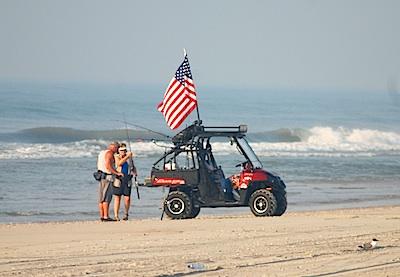
A congressman from North Carolina says there's no need for more ORV regulations at Cape Lookout National Seashore/Kurt Repanshek
A draft plan aimed at managing off-road vehicles at Cape Lookout National Seashore has been severely criticized by a congressman, who said there's no justification to either charge an $80 permit fee or restrict where ORVs can go on the national seashore.
Seashore officials released their draft ORV management plan earlier this year. Under the preferred alternative, ORVs would be able to travel most of Cape Lookout; the plan also would create three seasonal "pedestrian only" areas on the seashore. The proposed Cape Lookout National Seashore Off-Road Vehicle Management Plan/Environmental Impact Statement aims to put specific numbers to ORV traffic, specify where they can travel, formally set speed limits, and set seasons for when they can travel on the seashore.
But Rep. Walter B. Jones, in a letter sent to the seashore a month after the comment period closed, said the "restrictions" contained in the preferred alternative would "impose significant economic hardship on the local economy and are totally unnecessary to protect species of concern."
Under the proposed alternative, efforts to provide pedestrian only access during the summer months would cause the mileage open to ORVs to seesaw just a bit: 44 of the seashore's 56 miles would be open to ORVs from March 16 "through the Thursday preceding Memorial Day and from the day after Labor Day through December 15." Forty-one of those miles "would be available for ORV use from the Friday preceding Memorial Day through Labor Day. Routes within the Cape Lookout Village Historic District would be open to through vehicle traffic."
In his two-page letter, the Republican congressman said the Park Service seems to be searching for a solution to a problem that doesn't exist. Visitation to Cape Lookout has been on the decline, Rep. Jones pointed out, and additional regulations will own continue that downward spiral.
"The proposed permits, fees, and other access restrictions in Alternative C all but invite visitors to vacation elsewhere," he wrote. "American's hard-earned tax dollars already pay for the operation of the seashore; they shouldn't be charged an additional fee to access it."
Back in 2013 Rep. Jones introduced legislation that would force Cape Hatteras National Seashore to discard its court-approved ORV management plan and return to an interim plan adopted in 2007. The measure stalled in the House.



Comments
EC, you raise a good point...but cultures and businesses are a moving target, no? When the seashore was established in 1966, the current version of ORVs did not exist. Visitation did not eclipse 100,000 until 1988.
Nevertheless, visitation has been on a slide since 2011 (going from 601,954 in 2009 to 416,568 last year), which would seem to indicate something other than ORV access is the cause. Putting in what would seem to be a reasonable management plan, one required by an executive order signed by President Nixon 42 years ago, likely would have questionable, if any, impact on that trend.
It would be interesting to see if any studies have been done, either by the NPS or the state of North Carolina, on visitation trends and what might be behind this decline. It is a gorgeous national seashore, one with a very different feel (and appeal) than its neighbor to the north. I'd hate to think someone would decide the answer to the visitation drag is a bridge to the barrier islands.
No one is asking to drive anywhere. There have always been restrictions, resource closures, and designated trails. This misinformation is what our side gets upset about.
The 2011 slide in visitation has happened for the same reason it did at CHNSRA, the increase of resource closures. The use of much greater closure sizes restricted pedestrian and ORV access. This turned away a lot of visitors. That is the only thing that changed.
But at Cape Hatteras, visitation has been increasing since 2011, from 1.96 million in 2011 to 2.3 million in 2012 with a slight dip to 2.2 million last year.
And if you could be more specific re "resource closures," that'd be helpful. A quick search of Cape Lookout's website shows they've been doing closures for years. For instance, in 2008 they were closing areas from April 1 to August 31 due to nesting shorebirds and plovers, and yet visitation went from 486,899 in 2008 to 601,954 in 2009.
I wonder how much of the visitation ups and downs might be related to hurricanes more than resource closures?